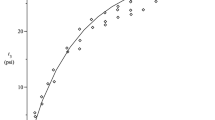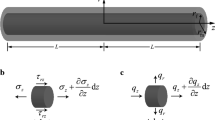Abstract
The strain energy for incompressible anisotropic non-linearly elastic materials is decomposed into an isotropic part representing the mechanical response of an isotropic matrix and an anisotropic part representing the contribution to the mechanical response from the presence of fibres. It is the form of the anisotropic component that is of interest here. We note that the invariants can themselves be divided into two classes: the invariants that are homogeneous functions of degree two and those of degree four in the principal stretches. The approach adopted here is straightforward: assume that there is a linear proportional relationship between terms in the general stress–strain law that are of the same degree in the principal stretches. Setting these constants identically zero recovers many of the simplified strain energies commonly found in the literature. The proportionality constants are interpreted as being a measure of the fibre–matrix interaction and a measure of the interaction between fibres in anisotropic non-linear elasticity. An influential model of fibre dispersion is recovered as a special case. The results are illustrated using the homogeneous deformation of simple shear.
Similar content being viewed by others
References
Humphrey JD (2002) Cardiovascular solid mechanics, cells, tissues and organs. Springer, New York
Humphrey JD (2003) Continuum biomechanics of soft biological tissues. Proc R Soc A 459(2029):3–46
Taber LA (2004) Nonlinear theory of elasticity: applications in biomechanics. World Scientific, Singapore
Ogden RW (2017) Nonlinear continuum mechanics and modeling the elasticity of soft biological tissues with a focus on artery walls. In: Holzapfel GA, Ogden RW (eds) Biomechanics: trends in modeling and simulation. Springer, Heidelberg, pp 83–156
Holzapfel GA, Gasser TC, Ogden RW (2000) A new constitutive framework for arterial wall mechanics and a comparative study of material models. J Elasticity 61(1):1–48
Holzapfel GA, Gasser TC, Ogden RW (2004) Comparison of a multi-layer structural model for arterial walls with a Fung-type model, and issues of material stability. J Biomech Eng 126(2):264–275
Horgan CO, Murphy JG (2020a) A constitutive model for fibre–matrix interaction in fibre-reinforced hyperelastic materials. Appl Eng Sci 2:100008
Gasser TC, Ogden RW, Holzapfel GA (2006) Hyperelastic modelling of arterial layers with distributed collagen fibre orientations. J R Soc Interface 3(6):15–35
Itskov M, Aksel N (2002) Elastic constants and their admissible values for incompressible and slightly compressible anisotropic materials. Acta Mechanica 157(1):81–96
Horgan CO, Murphy JG (2017) The counterintuitive out-of-plane strength of incompressible orthotropic hyperelastic materials. Int J Solids Struct 115:170–179
Horgan CO, Murphy JG (2014) Some unexpected behaviour in shear for elasticity models of arterial tissue that only use the I 1, I 4, I 6 invariants. IMA J Appl Math 79(5):820–829
Horgan CO, Murphy JG (2020b) Some unexpected predictions from strongly anisotropic hyperelastic constitutive models of soft tissue. Mech Soft Mat 2:article 9
Acknowledgements
We are grateful for the constructive criticism of the anonymous reviewers of an earlier version of this paper.
Author information
Authors and Affiliations
Corresponding author
Additional information
Publisher's Note
Springer Nature remains neutral with regard to jurisdictional claims in published maps and institutional affiliations.
Rights and permissions
About this article
Cite this article
Horgan, C.O., Murphy, J.G. A model for fibre–matrix interaction in non-linearly elastic incompressible orthotropic materials. J Eng Math 127, 25 (2021). https://doi.org/10.1007/s10665-021-10114-6
Received:
Accepted:
Published:
DOI: https://doi.org/10.1007/s10665-021-10114-6




